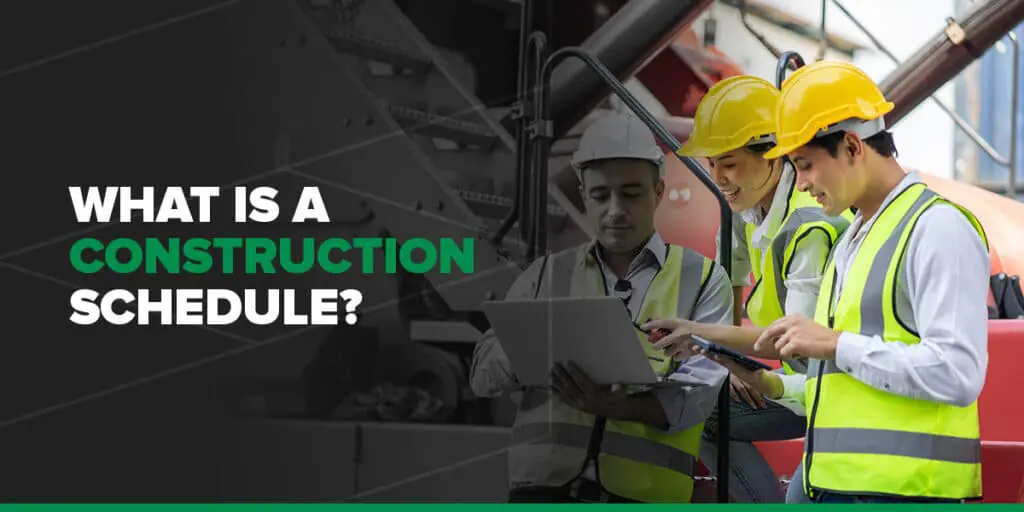
Completing a construction project and getting more of your bids accepted as a contractor or subcontractor can be tedious. Just like in the projects you’ve completed in the past, proper planning is the pillar on which the success of your construction project rests. This is where a construction schedule comes in.
In this article, you’ll learn what a construction schedule means, the purpose of a construction schedule, what should be included in a construction schedule and how a construction schedule is prepared. To make it even more useful, we share how to keep a construction project on schedule once you kick it off.
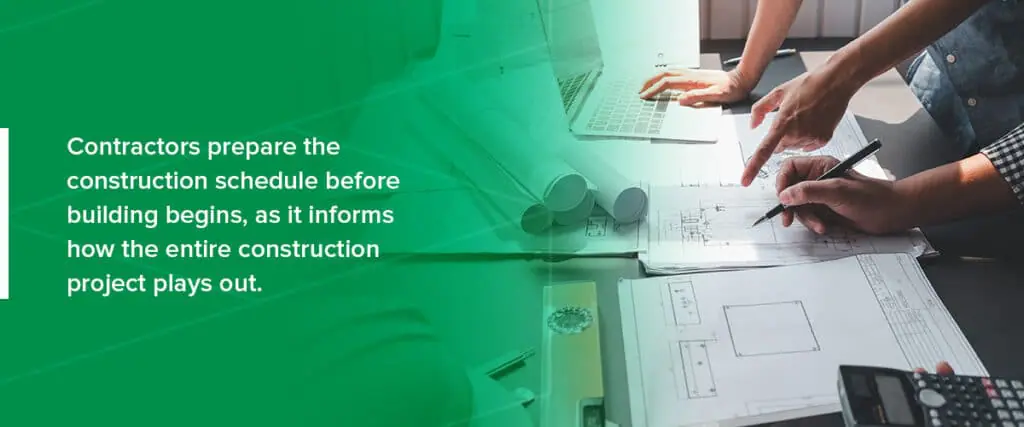
What Does a Construction Schedule Mean?
A construction schedule is a complete blueprint of the timeline of the activities, milestones, tasks and steps in the execution of a construction project leading to its final completion. In addition to outlining the timeline and how a project will move from start to finish, the construction schedule outlines the resources required, the teams, expertise and stakeholders involved and how you will allocate the resources.
Furthermore, the construction schedule outlines what each team member is responsible for. The construction schedule outlines the tasks that make up the project and the resources needed in the right order. It will aim to create a comprehensive guide you and all involved parties can refer to throughout the construction process for information about the various steps you need to take to complete the project.
Contractors prepare the construction schedule before building begins, as it informs how the entire construction project plays out.
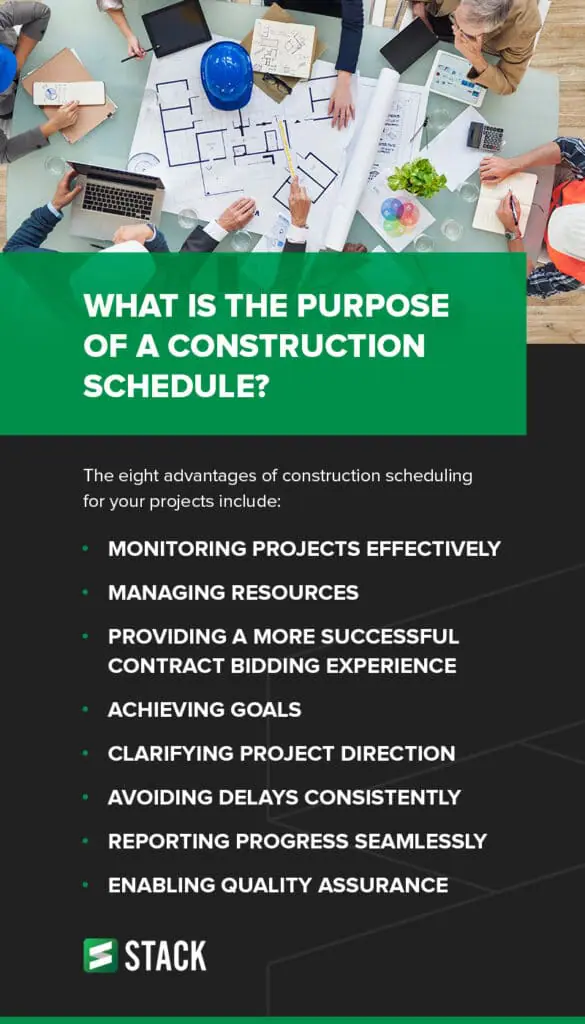
What Is the Purpose of a Construction Schedule?
Having a construction schedule can provide several benefits to construction teams, offering more visibility and information throughout projects.
The eight advantages of construction scheduling for your projects include:
- Monitoring projects effectively: A clear and comprehensive construction schedule enables you to monitor the progress of your project from beginning to end. This is because clearly laid out tasks, timelines and milestones provide you and your team with a clear idea of how your project is moving along.
- Managing resources: In addition to timelines, a construction schedule includes resources and how you plan on using them. Proper preconstruction planning helps you to allocate and manage whatever you have at your disposal.
- Providing a more successful contract bidding experience: A strong construction schedule from the general contractor lets you know the timeline for the completion of a project and the physical, human and financial resources you need to do your part. This enables you to create proper project takeoffs and estimates when bidding for work. As a result, this can increase your chances of landing the contract.
- Achieving goals: A comprehensive construction schedule is the first step to achieving your construction goals and completing your project at the right time. Whether you want to prioritize efficiency or communication, a construction schedule can be the tool you need to support your objectives and initiatives and foster growth.
- Clarifying project direction: A construction schedule is what you fall back on to get direction on the next steps to take. When you complete a task or milestone, your construction schedule tells you what the next step is. Seeing the progress you and your team have made from your schedule gives you a sense of achievement and direction.
- Avoiding delays consistently: According to your schedule, you should know what you need to prepare for a future task. This enables you to provide the needed resources on time and complete the prerequisite needed for the next task.
- Reporting progress seamlessly: With your construction schedule, you can easily report the progress of your project and team to stakeholders, from the owner or GC of the project to regulatory agencies and financial institutions. This helps to keep all the stakeholders of your progress updated consistently on your project.
- Enabling quality assurance: Because you normally complete this schedule before starting the construction work, you ensure you are using the right tools and resources. This helps to ensure you do quality work and avoid substandard processes and materials from the outset.

What Should a Construction Schedule Include?
Construction schedules should be comprehensive resources with several types of information included in them. Before you implement a construction schedule system at your company, you should understand each element, so you can use them to their full potential.
Here are the five core parts of your construction schedule:
- Duration: Your construction schedule specifies the duration of your construction project from start to finish. It also specifies the timeline for individual tasks and milestones for the entire project. Present these timelines as specific dates and time durations, so information is clear and available for all stakeholders.
- Resources: Your construction project identifies the resources — financial, material and labor — needed for the project. It also specifies how you plan on assigning them to the different tasks and milestones for the project and when you will need them. Also, the construction schedule specifies who’s responsible for the different parts of the project.
- Stakeholders: Your construction schedule includes the stakeholders on your team and specifies their responsibilities and duties in your project. This system can help boost communication, so each team member will understand everyone’s role and who they can go to with questions or concerns.
- Milestones: Milestones are significant accomplishments in the completion of your project. For example, this could be completing the electrical work for a construction project. Your schedule specifies all the milestones in your project in their sequential order.
- Tasks: Tasks are the individual activities your team needs to carry out. They are specific and add up to achieve your milestones and complete your project.
How to Create a Construction Schedule
Creating a construction schedule is arguably the best way to ensure your construction project goes as smoothly as possible. Now, let’s take a look at how you can prepare a construction schedule step by step:
Step 1: Identify the Stakeholders in Your Project
Your first step in creating a construction schedule is to make a list of all the parties involved in your construction project. Identify your stakeholders, including their names, roles, responsibilities, the team they’ll work with and when they’d come in for the project.
Stakeholders for your project may include the following people:
- Project owners
- Material suppliers
- Contractors
- Subcontractors
- Supervisors
- Regulatory agencies
- Workers
- Project leads
- Financiers
Increase clarity and communication by adding their contact information with their names and other data. Consider asking for a work phone number and email address. If they have a contact preference, note this, so you know which method to try first.
As you continue with your project, you can ensure you and other team members always know how you can reach them.
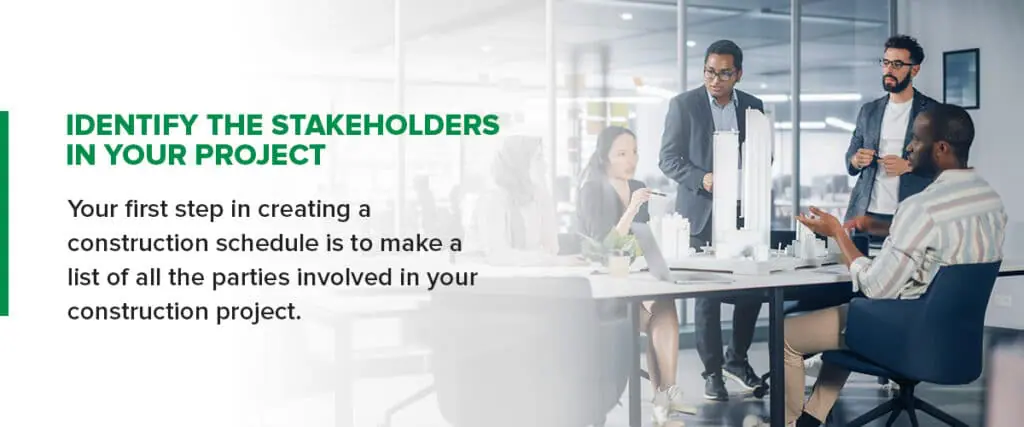
Step 2: Collect Information
Gather all the information you need to understand the scope of your project and what you need to do. For this step, you need to speak with the stakeholders involved in your project. For example, speaking with the general contractor will help you understand the specifications of the project and what they want as finished work.
If you have other subcontractors you hire out, speaking with them will enable you to know the materials and workforce they need to complete their part of the project, their work processes and the cost of the workforce needed. Speaking with your suppliers will help you understand the cost of the materials you need and how quickly you can get them.
Other information you need to gather includes details on regulations and construction codes in your location you need to follow. You’d also need to include information on the inspections that need to be done on your project. This will help you ensure your project is compliant and your employees have access to the information they need to maintain a safe work environment.
Collect all the information you need and keep it in one place. Having all your important data in a centralized location ensures the right people will always have access to it when necessary.
Step 3: Gather Resources and Tools
After getting all the information you need, you should know the resources you need to get for your construction project, including materials, labor and equipment.
Start making a list of the resources and tools you will need, noting when and the quantity and frequency of which you will need them. Further, you should take note of their costs so you understand how much of your budget you need to allocate to these items. Adding these details to your construction schedule can offer increased insights into your timeline and budget.
Outlining your expected costs in your construction plan can help you give potential customers and contractors a better idea of your finances. When you are upfront with your partners, you can expect a smoother building process with a client that understands what you expect from them.
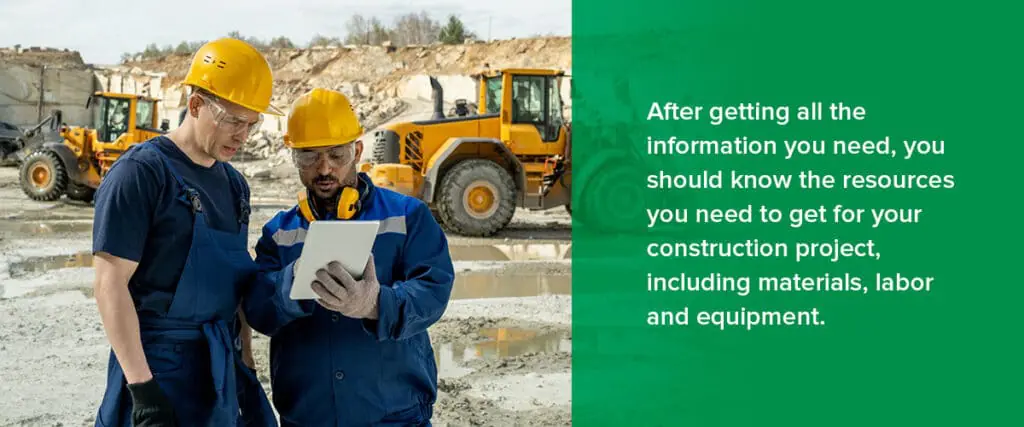
Step 4: Setup Milestones
After listing the resources you need for your construction project, outline the milestones for your project. Milestones are the major points in your project that indicate the completion of a significant phase of your project development.
For example, completing the drywall work for a project can be a milestone. Another example of a milestone could be completing painting for the project. You can consider milestones as little projects of their own — they’re the subprojects within your project as a whole.
Make a list of all the predicted milestones for your project. You can organize all of the parts of your project under milestones, helping you see if there is anything you are missing. Milestones can help ensure you are staying on track for finishing your project — it creates an outline you can use as a timeline to track project progress and keep your client updated throughout.
Step 5: Establish Tasks
The next step is to set up the individual tasks that will lead to each milestone and the completion of the entire project. Tasks include all the steps and activities you carry out in your project. They make up the foundation of your construction schedule and can be highly specific to make up each step in milestone completion.
The best way to set up and collect tasks is to break them down into the smallest structures possible. Then, order the tasks based on priority and sequence to ensure tasks that other jobs depend on get completed first. A common task management and setup methodology you can also use is the work breakdown structure (WBS).
With WBS, you break your project into smaller tasks and thoroughly list out all project duties, their scope and their dependencies. Using the WBS approach makes the entire project easier to manage for you and your team. The WBS is specifically helpful for projects that involve several moving parts, making it ideal for construction projects.
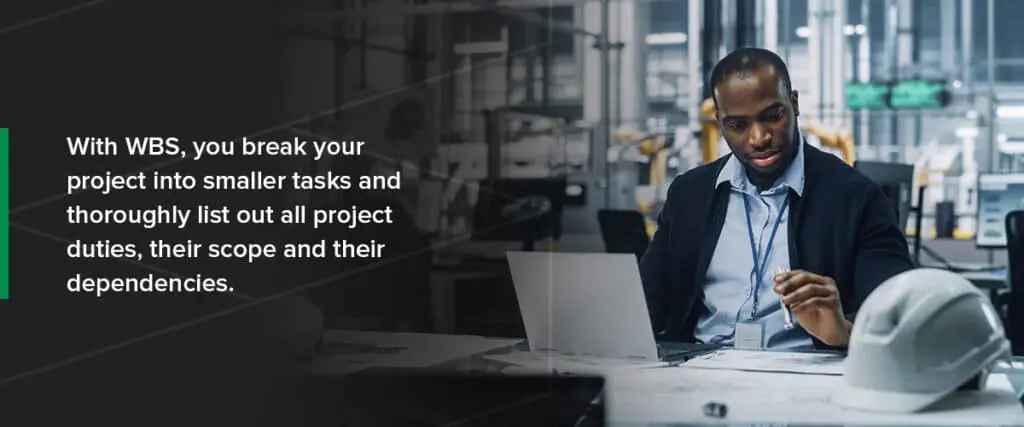
Step 6: Add Task and Milestone Durations
After listing out all your tasks and milestones, the next step is to add timeframes and durations to each of them. The best practice is to add start and finish dates to each task and milestone.
The following should influence the duration you specify for each task:
- Time for the entire project: You don’t want one task to take so long that you cannot meet the project delivery date. Having a timeframe for your project completion can help you determine when you should have each milestone and task finished, ensuring you can stick to that estimate.
- The climate and weather conditions: Some of your project tasks will be subject to varying weather conditions, especially if they’re exterior and exposed to the elements. Consider the climate of your project location and the weather conditions during the duration of your project. This will enable you to assign the right durations to each task and milestone. You can combine weather forecasts and historical weather data for your project location to understand what to expect during your project.
- Holidays during the project period: While setting up your task duration, pull out a calendar with the holidays in your project location. This will enable you to understand the number of days to subtract as no-work days as you plan your project. Marking these days will help you communicate work expectations with your employees and clients, so everyone understands the project’s timeline.
- Workers’ vacations and leaves: In addition to holidays, your team will likely take leaves from work, especially if you’re working on a project that will take several months or years. Consider these while working on your construction schedule. Knowing your employees’ schedules can signal when you might need to add extra hands to a project to ensure you can finish everything on time.
- Factor in delays: Some of the due dates and durations you specify in your project planning may not go as planned. There may be delays from suppliers, delays in getting needed funds or unanticipated extensions in the completion of a task. Consider all of these interruptions so your workflow will not be negatively affected when they occur. Allowing some flexibility in your plans is always best practice.
To boost your relationship with your contractors and subcontractors, strong communication and realistic timelines are key. While everyone wants results quickly, quality work might take longer. Work with your partners to establish an accurate timeframe in which everyone can work reasonably. Lack of an agreed-upon timeline can sometimes lead to poor quality of work and a lot of compromise in the battle against time.
Step 7: Assign Tasks
After adding duration and due dates to your tasks and milestones, the next step is to assign them to the stakeholders who are responsible for them. Proper task assigning helps to promote accountability across the project. At any time, you know who’s responsible for completing a task and where any delay originates.
In addition, assigning tasks from the planning stage helps all parties involved in the project be aware of what they’re responsible for and what their next tasks will be. They will know what you expect of them each day and how their work contributes to the overall completion of the project.
Using the right project management tool can enable you to assign tasks to your team digitally and provide remote access to everyone on your team. These days, incorporating technology into the construction planning phase can help streamline your efforts and improve your productivity.
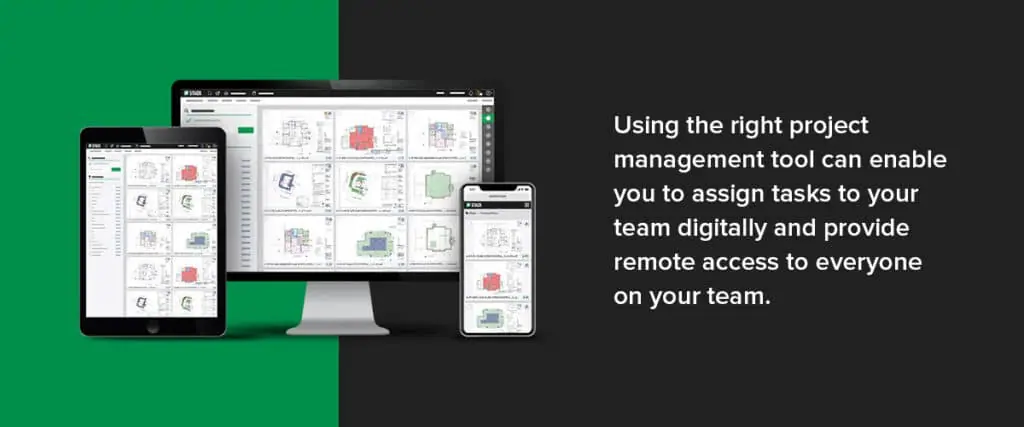
Step 8: Begin the Project
Now, you are set to start your project. Share your plan with all stakeholders, so everyone has the big picture of the project. As you implement this tool, you can track what works well for your teams and make adjustments to help further improve efficiency and communication.
If this is your team’s first time using this methodology, you should assess how it works for your processes so you can tweak it for better results in the future.
How Do You Keep a Construction Project on Schedule?
The key to keeping your project on schedule is to consistently review your construction schedules and make the right changes when necessary. Don’t think of your schedule as something that’s set in stone — various situations can arise, meaning you need to be flexible enough to keep things updated.
Review completed tasks, possible future risks and delays. Then, take steps to mitigate these risks and avoid these delays. The best construction schedule helps ensure you can complete tasks and milestones at the right time with the least possible delays. Being proactive when it comes to mitigating obstacles goes a long way to help you please your client.
Maintain a working schedule and on-track project through consistent review of your construction schedule. Communication on all levels can help keep project estimates accurate. Have employees submit daily reports about project progress, allowing you to note any changes. This process can help you continually include clients in progress updates, so they always have an accurate understanding of when to expect the finished product.
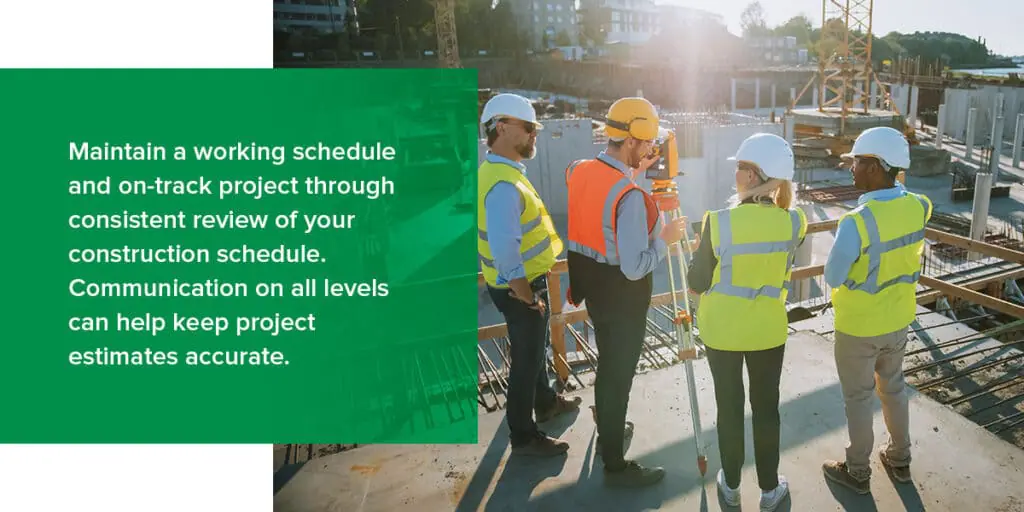
Let STACK Help You Organize and Tackle Your Projects
Creating a construction schedule can be a great way to organize your next construction project. By increasing information visibility and organization, you can provide more accurate time estimates for your clients and give your employees an idea of what this project will entail.
STACK’s construction management solution enables you to create detailed project schedules including dependencies so you can stay on track, collaborate with everyone and connect with everyone in your team from anywhere.
Sign up for a free STACK account today to start planning your project. You can also contact us to speak with our team or schedule a demo.







